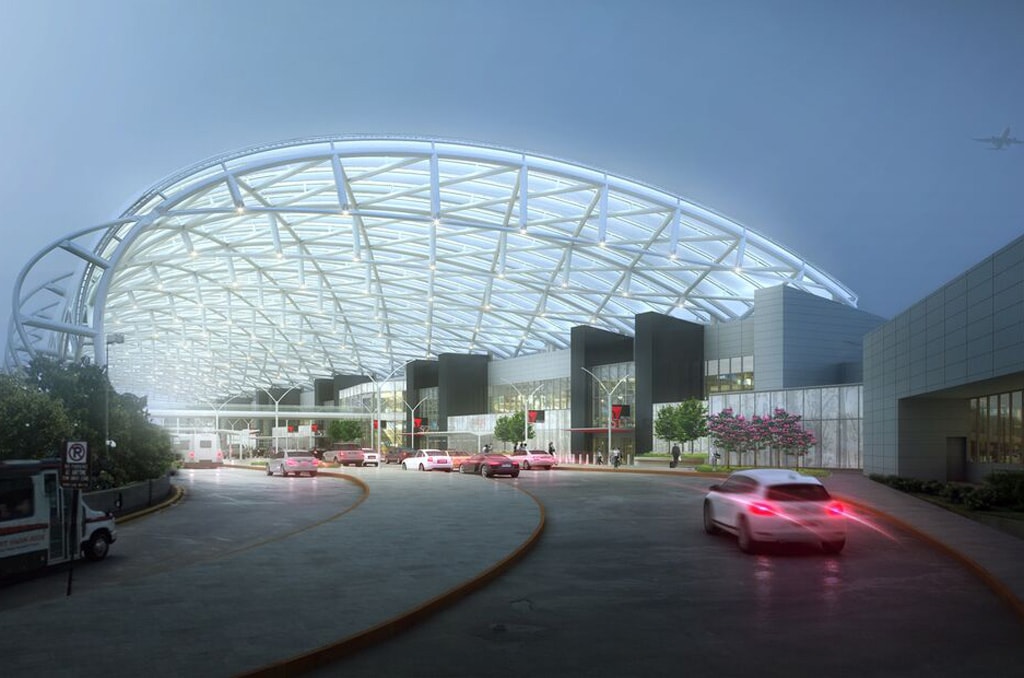Alternative ATL: World’s Busiest Airport to Get Futuristic Facelift
Share

APEX Insight: As part of an effort to retain Hartsfield-Jackson Atlanta International Airport’s position as the world’s busiest airport, city officials last month revealed ATLNext, an ambitious 20-year expansion and modernization blueprint. Global architectural and design firm HOK will be responsible for $200 million worth of improvements, including futuristic canopies and facades inspired by local scenery.
Being home to the world’s busiest airport isn’t just a matter of pride for Atlanta; according to some officials, much of the city’s economy depends on the volume of passengers passing through the airport each day. A 2014 study estimated the airport has created over 450,000 jobs in the region and contributed $64.3 billion to the Atlanta economy in 2013.
Last year, over 100 million passengers passed through the sprawling terminal buildings of Hartsfield-Jackson; this was enough to guarantee the airport’s position as the world’s busiest for the 17th year running. But fast-growing hubs in the Persian Gulf and the Far East, alongside an enduring domestic rivalry with Chicago O’Hare, means Hartsfield-Jackson isn’t resting on its laurels.
As part of an effort to retain Atlanta’s preeminent position, city officials last month revealed an ambitious 20-year expansion and modernization blueprint. At an event hosted by Atlanta Mayor Kasim Reed, a $6 billion program, dubbed ATLNext, was presented as a vision fostering a 21st century first-class passenger experience and strengthening the airport’s role as an ambassador for the region.

To help make this a reality, global architectural and design firm HOK will lead a joint venture responsible for designing $200 million worth of improvements and overhauling the design of the airport’s domestic terminal. “The airport’s vision is to create an exceptional experience for all its guests,” explains Ripley Rasmus, a senior design principal at HOK and the project’s lead designer. “Our team’s flexible design for the terminal modernization accommodates both the curb-to-gate weekly business travelers and the more leisurely visitors who may stop to patronize retailers and other airport amenities.”
The focal point of the recently unveiled design is a set of futuristic and imposing 864-foot long arched canopies composed of translucent ETFE (ethylene tetrafluoroethylene) panels. Rasmus says the aim is to use a modern palette of materials designed to redefine the passenger experience from the moment guests arrive at the airport. But he stresses that it’s not simply a case of form over function. “The canopies for both the north and south curbs will shade passengers from the hot Atlanta sun, shelter guests along the entire roadway from rain and encourage fresh air flow along the curbside.”

According to Rasmus, many aspects of HOK’s design were inspired by the city of Atlanta. Among the local touches, the terminal building will use facades featuring fritted glass panels that depict the forests of Atlanta’s surrounding regional landscape and images of its green city parks.
Ultimately, Rasmus suggests the project’s aim is to redefine and enhance Hartsfield-Jackson’s function and value to the city. “The design converts [the terminal’s atrium] from a processing space, into an engaging civic area that connects visitors and travelers to Atlanta.” According to Rasmus, the design will reinforce the role of “the airport as an ambassador for the region.”


